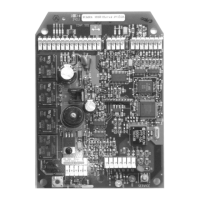
Do you have a question about the McQuay MicroTech 2000 and is the answer not in the manual?
| Brand | McQuay |
|---|---|
| Model | MicroTech 2000 |
| Category | Controller |
| Language | English |
Overview of hardware components like microprocessor and sensors.
Indicator for unit operating mode and alarm status.
Button for broadcasting Neuron ID for network commissioning.
Indicator for Neuron chip status during network configuration.
Details on NTC thermistors used for temperature measurement.
Prevents frequent compressor cycling with minimum on/off times.
Prevents simultaneous compressor startups after power events.
Manages reversing valve state to prevent 'swishing' during mode changes.
Detects and responds to condensate overflow, disabling the compressor.
Protects against low voltage conditions by de-energizing the compressor.
Responds to overpressure by de-energizing the compressor and reversing valve.
Handles low temp conditions by cycling to cooling or disabling the compressor.
Responds to low pressure by de-energizing the compressor.
Alerts when fan run time exceeds a set point, indicating filter replacement.
Controls electric heat based on loop temperature or space temperature.
Controls motorized valve to shut off water when compressor is inactive.
Controls fresh air damper operation based on fan status.
Provides timed control for auxiliary loads based on schedules.
Network communication for control, monitoring, and fault resets.
Details on optional sensors for room temperature and override functions.
Allows adjustment of room set point via a potentiometer.
Manual control to temporarily change operating mode or network address.
Essential steps and tools required before initial unit startup.
Verifying electrical connections against diagrams for proper installation.
Checks for correct wiring and termination of wall sensor cables.
Verifying proper termination of network communication cables.
How set points are stored and initially configured.
Step-by-step process for powering up and verifying WSHP operation.
Describes how the fan operates in different modes.
Details cooling cycle operation when the unit is unoccupied.
Details heating cycle operation when the unit is unoccupied.
Details cooling cycle operation when the unit is occupied.
Details heating cycle operation when the unit is occupied.
Unit state between heating/cooling modes with compressor off.
Manual activation of temporary occupancy or network functions.
How the unit responds to network load shedding commands.
System logic for determining the best time to reach occupied set points.
Describes the priority and handling of various fault conditions.
Command to identify unit network address via status LED and fan.
How the controller monitors and indicates alarm conditions.
Procedures for clearing automatically or manually reset faults.
Response to high pressure switch activation, disabling the compressor.
Response to low temperature switch activation, potentially disabling the compressor.
Response to low pressure switch activation, de-energizing the compressor.
Response to condensate overflow sensor activation, disabling the compressor.
Response to low voltage conditions, disabling the compressor.
Notification for fan run time exceeding hours, indicating filter replacement.
Overview of controller input and output connections.
Details on analog sensors and their terminal connections.
Details on digital inputs and their voltage/current requirements.
Details on digital outputs and their switching capabilities.
Reference tables for controller input/output connections.
Guidelines for diagnosing common WSHP controller issues.
Procedure for diagnosing microprocessor operational issues.
Procedure for diagnosing power supply issues to the controller.
Procedure to troubleshoot inaccurate temperature sensor readings.
Procedure to diagnose faults related to digital input circuits.
Information required for replacing a defective controller unit.